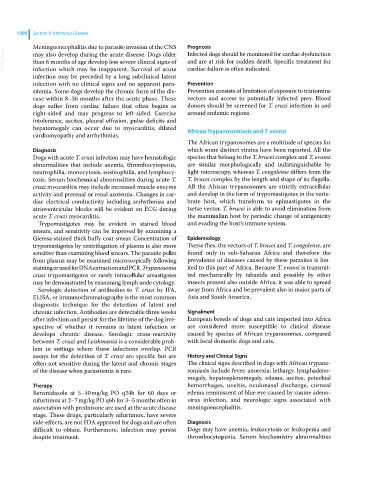Page 1070 - Clinical Small Animal Internal Medicine
P. 1070
1008 Section 9 Infectious Disease
Meningoencephalitis due to parasite invasion of the CNS Prognosis
VetBooks.ir may also develop during the acute disease. Dogs older and are at risk for sudden death. Specific treatment for
Infected dogs should be monitored for cardiac dysfunction
than 6 months of age develop less severe clinical signs of
cardiac failure is often indicated.
infection which may be inapparent. Survival of acute
infection may be preceded by a long subclinical latent
infection with no clinical signs and no apparent para- Prevention
sitemia. Some dogs develop the chronic form of the dis- Prevention consists of limitation of exposure to triatomine
ease within 8–36 months after the acute phase. These vectors and access to potentially infected prey. Blood
dogs suffer from cardiac failure that often begins as donors should be screened for T. cruzi infection in and
right‐sided and may progress to left‐sided. Exercise around endemic regions.
intolerance, ascites, pleural effusion, pulse deficits and
hepatomegaly can occur due to myocarditis, dilated African Trypanosomiasis and T. evansi
cardiomyopathy and arrhythmias.
The African trypanosomes are a multitude of species for
Diagnosis which some distinct strains have been reported. All the
Dogs with acute T. cruzi infection may have hematologic species that belong to the T. brucei complex and T. evansi
abnormalities that include anemia, thrombocytopenia, are similar morphologically and indistinguishable by
neutrophilia, monocytosis, eosinophilia, and lymphocy- light microscopy, whereas T. congolense differs from the
tosis. Serum biochemical abnormalities during acute T. T. brucei complex by the length and shape of its flagella.
cruzi myocarditis may include increased muscle enzyme All the African trypanosomes are strictly extracellular
activity and prerenal or renal azotemia. Changes in car- and develop in the form of trypomastigotes in the verte-
diac electrical conductivity including arrhythmias and brate host, which transform to epimastigotes in the
atrioventricular blocks will be evident on ECG during tsetse vector. T. brucei is able to avoid elimination from
acute T. cruzi myocarditis. the mammalian host by periodic change of antigenicity
Trypomastigotes may be evident in stained blood and evading the host’s immune system.
smears, and sensitivity can be improved by examining a
Giemsa‐stained thick buffy coat smear. Concentration of Epidemiology
trypomastigotes by centrifugation of plasma is also more Tsetse flies, the vectors of T. brucei and T. congolense, are
sensitive than examining blood smears. The parasite pellet found only in sub‐Saharan Africa and therefore the
from plasma may be examined microscopically following prevalence of diseases caused by these parasites is lim-
staining or used for DNA extraction and PCR. Trypanosoma ited to this part of Africa. Because T. evansi is transmit-
cruzi trypomastigotes or rarely intracellular amastigotes ted mechanically by tabanids and possibly by other
may be demonstrated by examining lymph node cytology. insects present also outside Africa, it was able to spread
Serologic detection of antibodies to T. cruzi by IFA, away from Africa and be prevalent also in major parts of
ELISA, or immunochromatography is the most common Asia and South America.
diagnostic technique for the detection of latent and
chronic infection. Antibodies are detectable three weeks Signalment
after infection and persist for the lifetime of the dog irre- European breeds of dogs and cats imported into Africa
spective of whether it remains in latent infection or are considered more susceptible to clinical disease
develops chronic disease. Serologic cross‐reactivity caused by species of African trypanosomes, compared
between T. cruzi and Leishmania is a considerable prob- with local domestic dogs and cats.
lem in settings where these infections overlap. PCR
assays for the detection of T. cruzi are specific but are History and Clinical Signs
often not sensitive during the latent and chronic stages The clinical signs described in dogs with African trypano-
of the disease when parasitemia is rare. somiasis include fever, anorexia, lethargy, lymphadeno-
megaly, hepatosplenomegaly, edema, ascites, petechial
Therapy hemorrhages, uveitis, oculonasal discharge, corneal
Benznidazole at 5–10 mg/kg PO q24h for 60 days or edema reminiscent of blue eye caused by canine adeno-
nifurtimox at 2–7 mg/kg PO q6h for 3–5 months often in virus infection, and neurologic signs associated with
association with prednisone are used at the acute disease meningoencephalitis.
stage. These drugs, particularly nifurtimox, have severe
side‐effects, are not FDA approved for dogs and are often Diagnosis
difficult to obtain. Furthermore, infection may persist Dogs may have anemia, leukocytosis or leukopenia and
despite treatment. thrombocytopenia. Serum biochemistry abnormalities

